
Lost & Found: The CUNY Poetics Document Initiative is excited to announce the recipients of our 2018 Grants and Fellowships! Lost & Found supports and mentors CUNY graduate students as they research and contextualize archival materials as part of our annual Research Stipends program. This year, thanks to generous support from the Early Research Initiative at the Graduate Center, CUNY, we have offered 11 students financial and logistical support as they traveled to archives here and abroad, both personal and institutional, developing their innovative research. These projects will take on a number of final forms—dissertations, Lost & Found chapbooks, or full-length books published in collaboration with a larger press as part of our Lost & Found Elsewhere series.
The 2018 Archival Research Grants and Fellowship have been awarded to the following CUNY graduate students: Khaled Al Hilli, Christopher Green, Gillian Sneed, Liz Donato, Josh Barber, Robert Robinson, Stefano Morello, William Camponovo, Christopher Clarke, Mary Catherine Kinniburgh, and Iris Cushing. Read below about their projects that dive deep into the archives and works of Sargon Boulus, William Carlos Williams, Ed Sanders, Muriel Rukeyser, the Valparaíso School, Jim Schoppert, Lawrence Livermore, the Black Panther Party’s Oakland Community School, Bernadette and Rosemary Mayer, and Diane di Prima.
2018 ARCHIVAL RESEARCH GRANT PROJECTS
Robert Robinson
Robinson’s current research project looks at the Black Panther Party’s Oakland Community School. It began as the Children’s House in 1970 and became a full-time elementary school from 1973 until the Party’s end in 1982. The school received state recognition as a model school of its kind for its commitment to students of color in the Bay Area. One aspect of his summer’s work examines narratives about race and gender within the school, specifically looking at Black hair and care as spaces for fostering solidarity and challenging fixed gender norms.
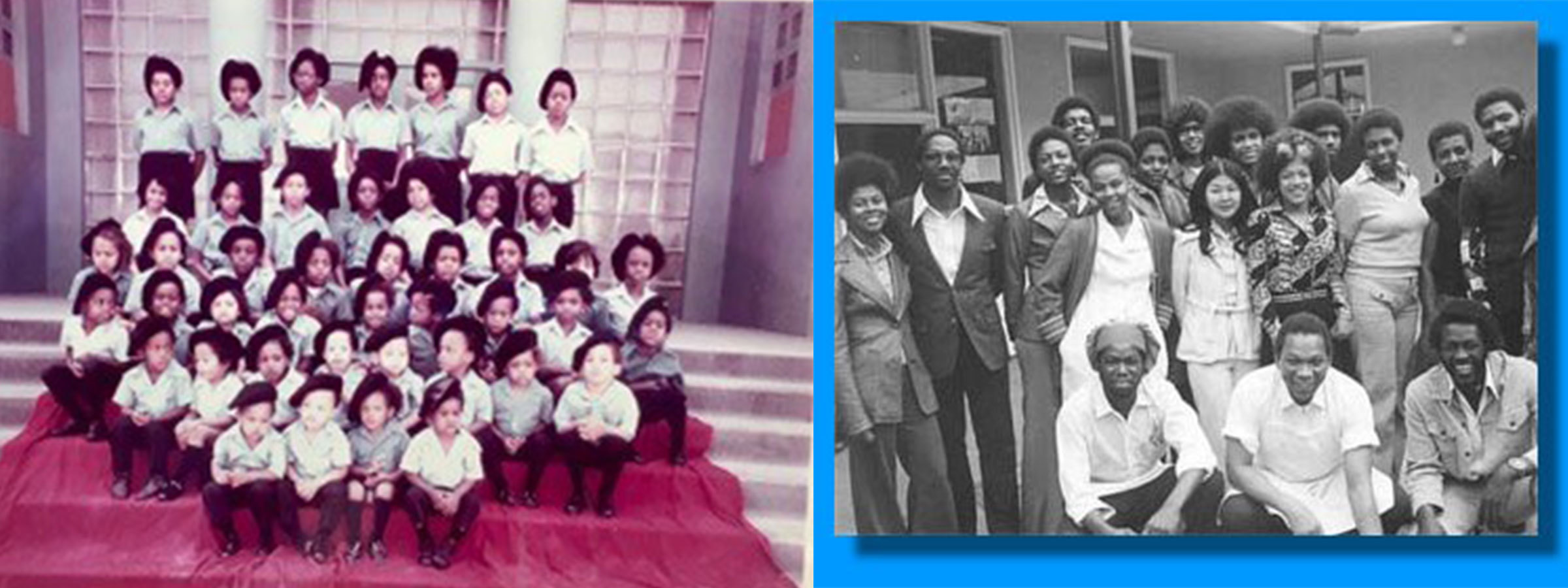
Gillian Sneed
The Correspondence between Bernadette and Rosemary Mayer
(In collaboration with Marie Warsh with input from Bernadette Mayer)
This Lost & Found Research project explores the correspondence and collaborations between the poet Bernadette Mayer (b. 1945) and her sister, the artist and writer, Rosemary Mayer (1943–2014). While Bernadette is well-established as an avant-garde writer associated with the New York School of poets—her many celebrated collections of poetry include Midwinter Day (1982, 1999), A Bernadette Mayer Reader (1992), and Works and Days (2016)—Rosemary’s work has only recently been reexamined, but has received critical acclaim. This project builds on recent interest in and critical examination of the work of both sisters, providing the first in-depth exploration of their relationship. Rosemary and Bernadette’s artistic partnership began with 0 TO 9, which was edited by Bernadette and Rosemary’s then-husband, the conceptual artist Vito Acconci (1940–2017). During the early 1970s, the sisters participated in overlapping avant-garde artistic circles, Bernadette becoming well-known as an experimental poet, and Rosemary participating in the feminist art movement, working on large-scale fabric sculptures and public art installations. During the second half of the 1970s, they lived apart and carried out an extensive and rich correspondence, preserved in their archives, the Bernadette Mayer Papers (1958–1996), housed at UC San Diego, and the Rosemary Mayer Estate and Archives, located in New York. Though the correspondence in their archives spans the 1960s to the 1990s, this project focuses primarily on their correspondence from the 1970s. These letters, written during an extraordinarily creative period for both women, reveal their shared intellectual and artistic influences, news of family and love relationships, and the struggles and challenges women artists faced at that time. Uncovering previously unseen materials in their archives sheds light not only on their personal connection and artistic collaborations, but also illuminates the intersections between the poetry and art worlds during the late 1960s and throughout the 1970s.
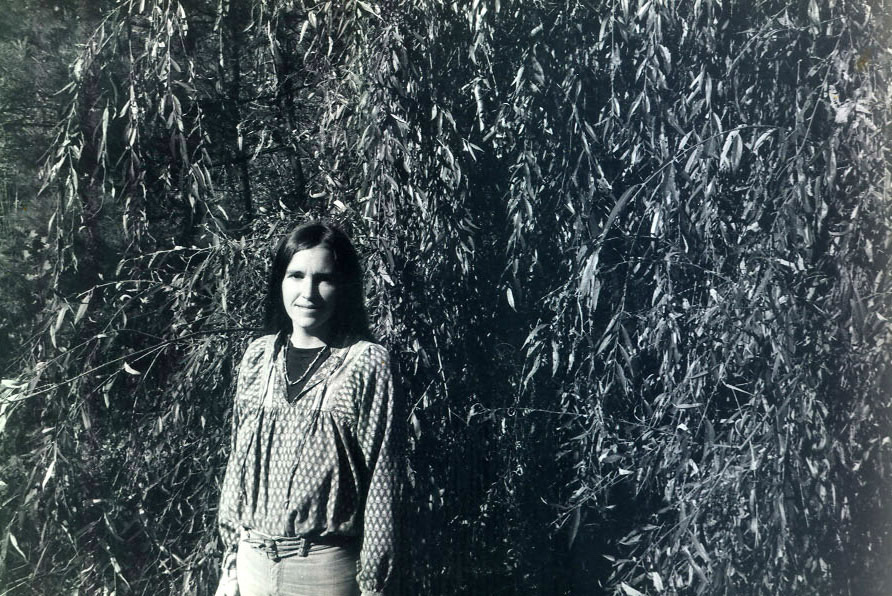

Khaled Al Hilli
Khaled Al Hilli’s project will try to trace some of the literary encounters of Sargon Boulus, an Iraqi poet who was part of the vibrant literary scene of late 60’s San Francisco. Boulus’s life (1944-2007) was marked by a period of restless traveling that he would later describe as an attempt to pursue a poetic imaginary. These relentless geographical transitions, punctuated by a long stay in the US, were driven by an overriding desire to form a new aesthetic vision for Arab poetics.
Boulus’s life in the US has inevitably left a trail of creative collaborations and literary connections that are yet to be explored. This project aims to investigate his proximity to the Beat poets, his short-lived Bay Area poetry journal, Tigris, and his other English language publications. It will also explore some of his collaborations with literary figures such as Allen Ginsberg, Bob Kaufmann, and Gregory Corso, all of whom played a significant role in Boulus’s literary formation, helping him further formulate his vision for a modernist, cosmopolitan poetics in Arabic.
Josh Barber
In “The Poem as a Field of Action,” a 1948 lecture delivered at the University of Washington, William Carlos Williams announced that “the only reality we can know is MEASURE.” As a remark on poetics and the so-called “American idiom,” the importance of Williams’ phrase to future (New) American poetry and statements of the same order—like Charles Olson’s “Projective Verse” or Robin Blaser’s “Practice of the Outside”—cannot be overestimated. However, as a contribution to the field of philosophy devoted to problematics of “being-in-language” or “literary space,” Williams’ comment (and Olson’s, and Blaser’s) has gone virtually unnoticed. Far from attempting to “legitimize” New American poetry as philosophy proper, this project challenges our tendency to turn to philosophy when we put being or reality into question by uncovering and investigating works—diaries, letters, unpublished essays, or lectures—by predecessors and practitioners of the New American tradition like Williams or H.D. in the archives held at Yale’s Beinecke Library. These hidden works speak not only to the poetry that was to follow but to those problematics for which philosophy “proper” has always had the last word. Of particular interest to this project thus far has been other of Williams’ (unpublished) lectures given around the time of “The Poem as a Field of Action,” in which Williams not only develops and qualifies his mature ideas of measure but, at the same time, announces his qualms with, and corrections to, metaphysics. This project’s animating concern, then, is to uncover, as Williams puts it, that “profusion” of poetics texts buried in the archives that articulate the New American Poetry’s position as a particular mode of interacting with and challenging what reality is or could be.
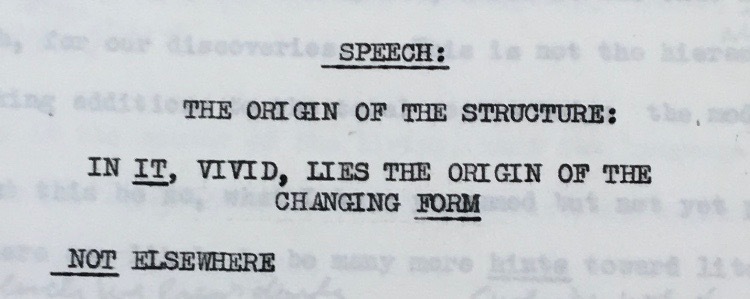
William Camponovo
This project aims to present a version of poet-editor-musician-artist Ed Sanders’ Charles Olson Memorial Lecture, given at SUNY Buffalo in 1983. This lecture series, a staple in the 1980s at Buffalo, invited a poet each year to give a series of talks about poetry and poetics—often Olson-influenced, but always deeply personalized and wholly unique. Sanders’ lecture is, like his work, like his career, impossible to pin down in a single phrase. It is part poetry, part conversation—a journey through Olson’s poetics and Sanders’ investigative poetry. A group of CUNY editors is working together to showcase this document as the vibrant, complex performance it was and still remains.
This project aligns itself with previous Lost & Found chapbooks that feature Charles Olson Memorial Lectures given by Robert Duncan, Diane di Prima, and Ed Dorn. It is hopeful that this current Sanders work in the Poetry Collection at the University of Buffalo Library will offer new avenues to explore and publish further poets from this vital reading series.
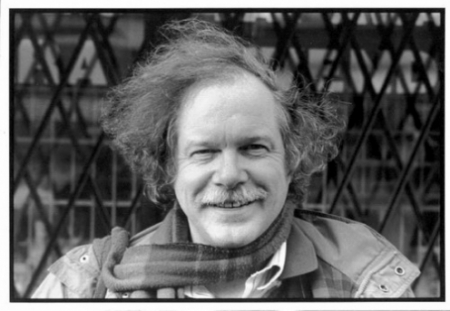
Chris Clarke
This research project examines Muriel Rukeyser’s translations of Arthur Rimbaud. Around 1940 or 1941, New York poet Muriel Rukeyser translated Rimbaud’s seminal poems Une saison en enfer (A Season in Hell) and Voyelles (Vowels). The multiple (incomplete) drafts of these unpublished translations are compared in the hopes of determining a poetics of translation particular to Rukeyser, and her reading of Rimbaud is set in comparison to other period translations by Delmore Schwartz (1939) and Louise Varese (1945 & 1952).
Stefano Morello
This project is invested in providing democratic access to the punk cultural production that emerged in the San Francisco Bay Area between 1985 and 1994. Morello is creating and curating an online digital archive, conducting research in personal collections, and collaborative ethnographic work with key participants in the scene. Lawrence Livermore’s Lookout! Magazine, yet to be collected in its entirety in any institutional archive, plays a central role in this project, as it represents an extraordinary, previously unearthed, document of punk’s alternative modes of existence and access to/production of knowledge.
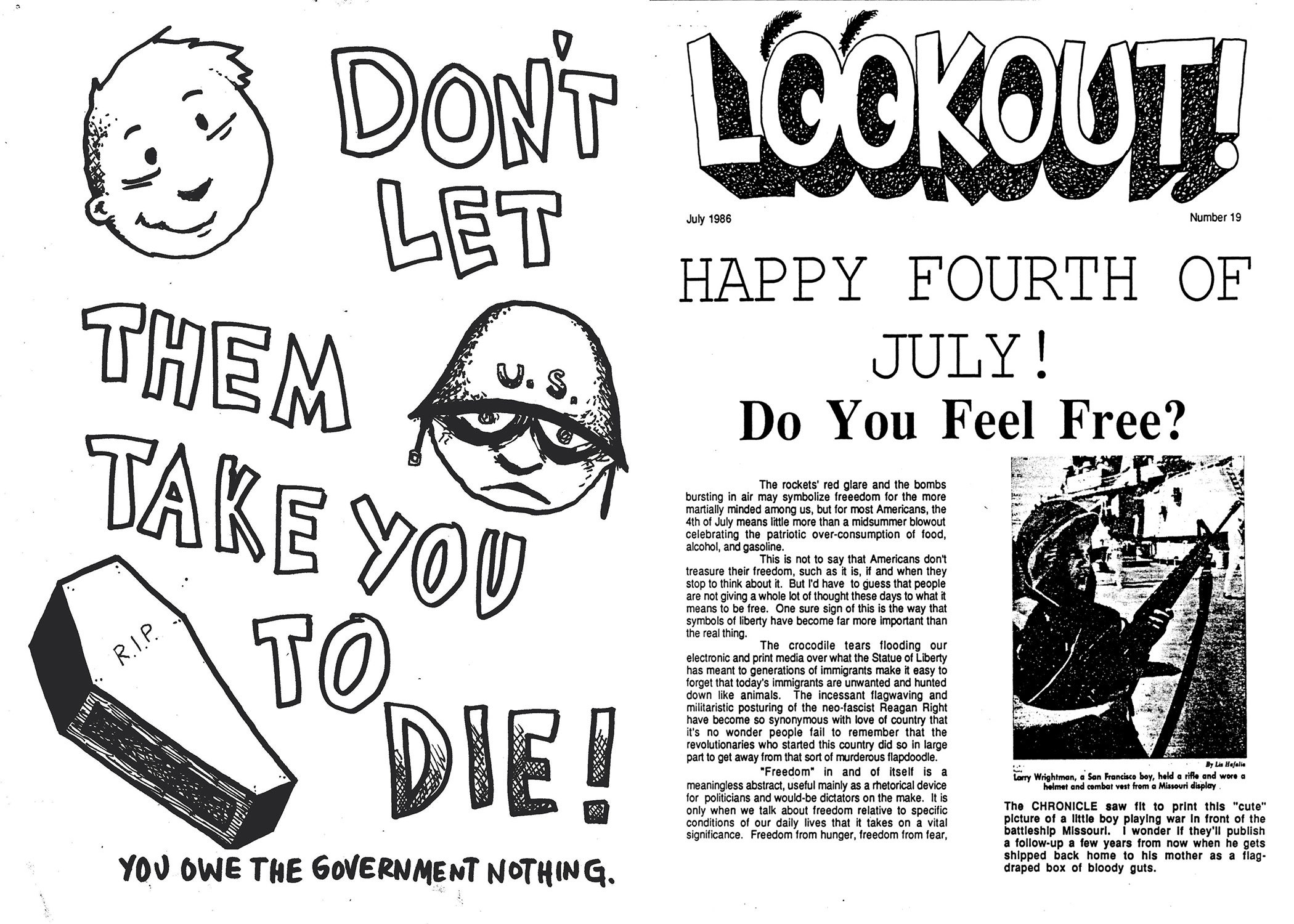
Liz Donato
This project examines the archival traces of a group of ‘poet-architects’ in postwar Chile known as the Valparaíso School (f. 1952), with a specific focus on its non-architectural production (exhibitions, poetic actions, journeys, and games). The Lost & Found Archival Research Grant will bring Donato to the newly inaugurated Fundación Alberto Cruz Covarrubias—who was the co-founder of the School along with the Argentine poet Godofredo Iommi—in Santiago, Chile. She will devote particular attention to materials related to the School’s construction of “América” and geopoetic voyages such as the “Viaje a Vancouver” (1969), which included encounters with Robert Duncan in San Francisco, Iván Illich and students at the Centro Intercultural de Documentación (CIDOC) in Cuernavaca, and anthropologist Duane Metzger at the countercultural research site “The Farm” at UC Irvine. A close analysis of these documents brings to light unexpected cross-continental networks of poetics and experimental pedagogies in the Americas in the 1960s.
Christopher Green
Morse Code for Creation: Jim Schoppert’s Tlingit Poetics
Tlingit artist Jim Schoppert (1947-1992) is best known for a practice rooted in a multiplicity of traditions, sources, and visual languages, in particular his combination of Northwest Coast Native design and expressionist painterly form in large abstract carved wooden panels. However, Schoppert was also a prolific writer whose poetry and prose explored his understanding of how Tlingit knowledge and practice operated within, rather than separate from, his experience of modernity. Relatively little of his writing has been published, and no attention has been paid to how it compliments his visual practice and elucidates his views on art and culture that, in the midst of the broader postmodern moment, were decades ahead of the neo-traditional world of Northwest Coast Native art. This project explores his unpublished writings and poetry to provide insight into and context for Schoppert’s innovative views on the relationship of tradition, Indigenous culture, and contemporary art.
DIANE di PRIMA FELLOWSHIP
Iris Cushing
Diane di Prima: Prometheus Unbound as a Magical Working
Diane di Prima’s “Prometheus Unbound as a Magickal Working” was originally composed as a lecture and delivered at the New College of California in 1984. Di Prima begins with the claim that Percy Bysshe Shelley’s 1819 lyrical drama Prometheus Unbound is “… a magical ritual to be performed in the mind’s eye, or more accurately, in the realm of the Imagination.” Di Prima walks readers through each Act of Prometheus Unbound—its plot, characters, mythological meaning, and the music of its language—revealing how the play functions to let us “envision…the new order we seek to bring about.” Included in the original notes for the lecture (written on a yellow legal pad as the poet sat in the San Francisco Botanical Garden) is a chart noting the “cognates” that di Prima finds between each Act of Shelley’s play and several hermetic/gnostic systems she is familiar with (such as Crowley’s Tarot, Kabbalah, Tetragrammaton; as well as the color, element and action cognate with each Act). The lecture bridges di Prima’s investigations into Romantic poetry with her extensive knowledge of alchemical and hermetic traditions. She emphasizes the importance of approaching poetry as something that can transform one’s mind in an actively and literally magical way, positioning Shelley as a poet uniquely capable of communicating the means for this transformation. Finally, di Prima insists that it is up to us, here and now, to “find the way to bring science magic + poetry into a unified vision…it is the most urgent + most terrible demand that is made of us as artists.”
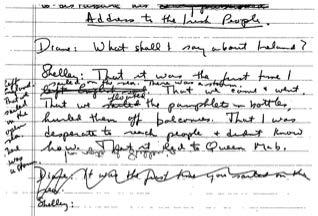
Mary Norbert Korte: Response to Ghost Tantras
In 1967, while still a Dominican nun at St. Rose Convent in San Francisco, the poet Mary Norbert Korte attended a reading in which Michael McClure read his newly-published Ghost Tantras. Korte brought a copy of McClure’s book back to the convent with her. Moved by the innovative syllabic pulse of the language, Korte composed her own lyrics in response to McClure’s and wrote them down in her copy of Ghost Tantras. “These responses do not pretend to be an interpretation of the Ghost Tantras,” wrote Korte on the first page of the book. “They are my reaction to a mood born in me of the poem…I would like to think that I have come close enough in ecstasy to understand the elemental language of mammals.” Korte tests this understanding over the next 80 pages, in dense, crystalline lines informed by her religious practice and knowledge of mystical texts. Fifty years later, this sole-existent copy of Korte’s lyrics was found by Ammiel Alcalay in McClure’s archive at the University of British Columbia. Mary Norbert Korte: Response to Ghost Tantras includes a conversation with the poet upon reading these poems again for the first time since they were written. One of the last living poets of her generation, Korte reflects on the cultural transformations that arose around the San Francisco renaissance, and her own spiritually-transformative contributions to New American Poetry.
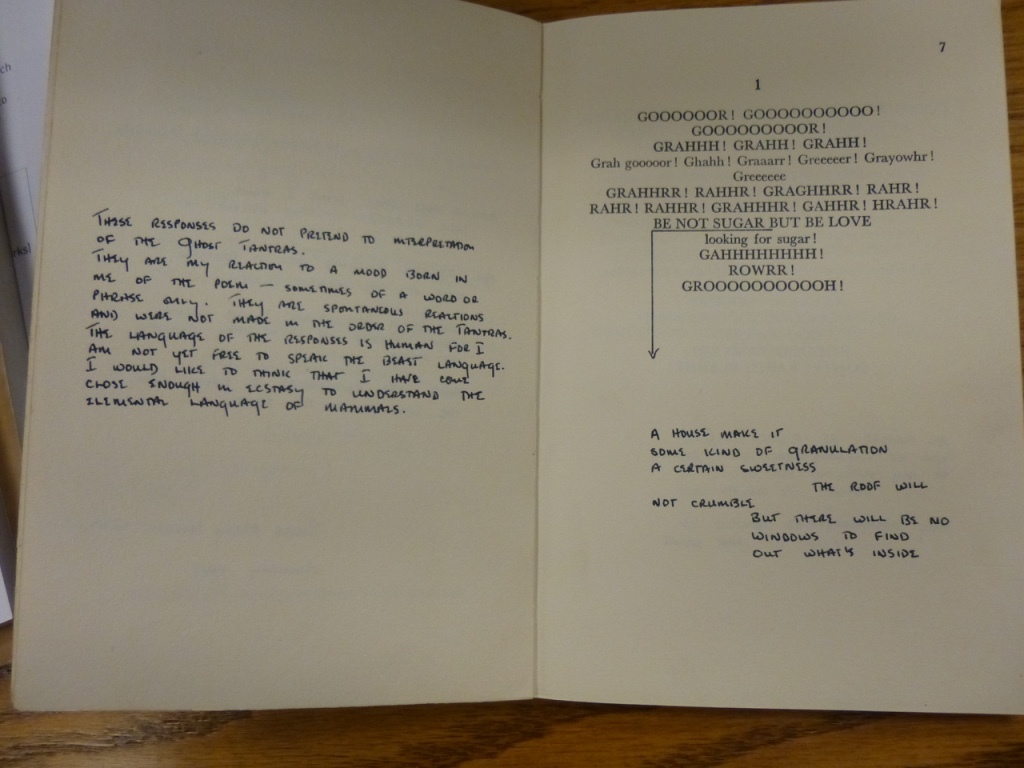
Mary Catherine Kinniburgh
In the poet Diane di Prima’s house, rows of custom-built shelves house hundreds of volumes of her self-identified ‘occult library’–materials she began gathering in the 1960s to the present moment, and arranged by subjects from crystal healing to Aleister Crowley, Atlantis to medieval mysticism, Soma ritual to astrology. Often richly annotated by di Prima for her “Hidden Religions” course taught at New College, or interspersed with poetry she would receive while the book was handy, these volumes represent di Prima’s specific approach to collecting, collating, and interrogating poetic knowledge in its material form–books, pamphlets, xeroxes, pressed flowers, and illustrations. This project describes the experience of encountering the library in-person, as a preliminary to support eventual cataloging and documentation, and also incorporates interviews with di Prima on the nature of her research, book collecting, and approaches to knowledge-building as part of her poetic practice.
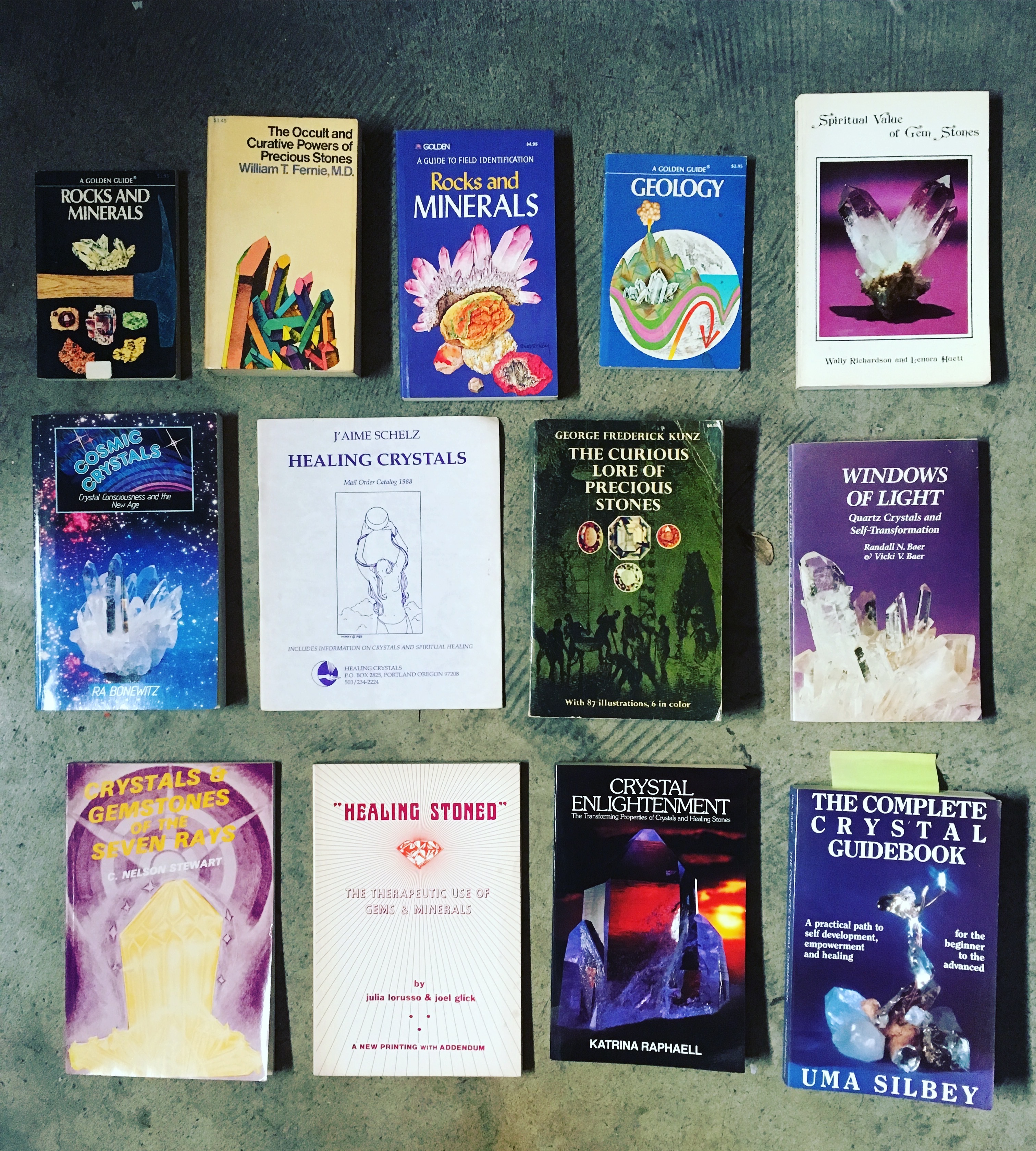
The 2018 Lost & Found Archival Research Grants were made possible by generous support from the Early Research Initiative at the Graduate Center, CUNY.